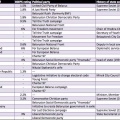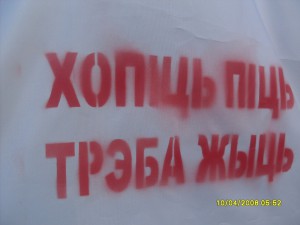Political Activists in Belarus: a Portrait

Image from Encyclopedia Britannica
Last week, the Belarusian Institute for Strategic Studies (BISS) released a new ranking of Belarusian political activists based on media coverage in January-March 2013.
The BISS study suggests an undersupply of political initiative among Belarusian political figures. According to BISS, the quantity and quality of political communication by Belarusian opposition figures do not necessarily go together – possibly a symptom of the uneven playing field in authoritarian regimes such as Belarus.
This article uses the BISS list as a representative sample of Belarusian political opposition figures to learn about these people’s paths into politics. Belarusian political activists are highly educated, are likely to be affiliated with political parties and have suffered arrests and imprisonment. Strikingly, one fifth of the political figures on the BISS list are in exile. Even so, for many political repression has become a right of passage into political visibility.
Measuring Political Communication: Media Barometer BISS
The BISS study examined both qualitative and quantitative characteristics of media communication. The study went beyond being academic and aimed at contributing to the improvement of political communication in Belarus. The quantitative index measured the number of media references and the size of audience covered by the online and print media as well as personal communications. The qualitative index takes into account the content of media references and consists of indices of expertise, initiative, and political action.
The figures on the BISS list are political actors broadly defined; many of them are civil society activists rather than politicians. According to BISS, among the top-12 political figures include distinct groups: a group with a high quantity of communication but average quality; a group with the most balanced quality communication, a group of women politicians with a high quantity of communication but “a complete absence of political initiative”.
Analtoly Liabedzka leads as far as the quantity of political communication goes, with 197 references in the media and the largest audience. Uladzimir Niakliaeu, at 244 references in the media occupies the second place, and Andrey Sannikau finds himself in the third place. Notably, these politicians feature in the media due to their political activity rather than personal life events or the bad luck of being imprisoned.
The only politicians according to BISS to have voiced new economic initiatives, Andrei Dzmitryeu and Aleksei Yanukevich, have high marks on the qualitative index but much less impressive quantitative results. Aliaksandr Milinkevich, Aliaksei Yanukevich, Andrei Dzimtyieu, and Vital Rymasheusky have the most “balanced” communications, in terms of both quantitative and qualitative media presence.
 This indicates the absence of political debate over important issues in Belarusian media. In fact, many political figures resemble citizen bloggers, expressing opinions but not engaging in constructive discussions over solutions of the day-to-day problems facing Belarusian citizens.
This indicates the absence of political debate over important issues in Belarusian media. In fact, many political figures resemble citizen bloggers, expressing opinions but not engaging in constructive discussions over solutions of the day-to-day problems facing Belarusian citizens.
Some opposition politicians prefer to pose as victims and freedom fighters rather than address the mundane issues that interest the average Belarusian citizen. Of course, the dependence of Belarusian political activists on foreign donors may explain such behaviour. In the end, this limits the opposition’s appeal in Belarus.
How well do Belarusians know the figures on the BISS list? In June 2013 the Independent Institute of Socio-Economic and Political Studies (IISEPS) published a study, which indicated that only about a quarter of respondents came up with names of politicians who represent an alternative to the current president of Belarus.
When offered a list with names of politicians, however, the IISEPS respondents produced rankings slightly different from the ordering of the BISS study. One reason for this discrepancy could be that the BISS study took place at the time of relatively low political activity, with no elections on the horizon. A few names included in the IISEPS were missing completely from the BISS list, however.
Who Becomes a Political Activist in Belarus?
The provisional character of the BISS rankings notwithstanding, the biographies of the political actors mentioned by BISS allow learning more about the careers of people who become visible in Belarusian politics. Although each actor has his own background, the basic features that many of them share common characteristics.
First of all, six out of thirty on the list live in exile in Western Europe or the United States. Political asylum undoubtedly limits these people’s influence in Belarus, so their visibility in Belarusian media may appear surprising.
The average age of a political activist in Belarus is 50, with Stanislau Shushkevich, aged 78, being the oldest and Anastasia Palazhanka, aged 22, – the youngest representative. More than half of the people on the BISS list come from Minsk.
Only two out of thirty people on the list are independent from any political party or movement. Given the underdevelopment of the Belarusian political sphere and the wariness of political parties as such after the decades of Communist dominance, this strikes as a remarkably high number. After all, in June 2013 IISEPS study, only 15.3% of respondents said that they trusted the opposition parties. Even so, the Belarusian parties remain far from being truly programmatic, and the popularity of the people in the BISS list focuses to a large extent on personalities.
Two paths to political opposition stand out from the biographies of people in the BISS list. One was followed by the political figures well-known already in the 1990s. These people have some political experience, having served in the Supreme Soviet of Belarus, regional representative bodies, or diplomatic service. Some even initially cooperated with the Lukashenka regime. For nearly all of them, the constitutional referendum of 1996 became a turning point, marking the start of their careers in political opposition.
Another group came into politics from other paths of life, with their political experience starting in the Belarusian Popular Front, Charter97, or as citizen journalists. These people first came into the spotlight after their arrests. The very real repercussions of their political activities have made their names familiar to the general public in Belarus as well as to the international organisations and probably strengthened their motivation to stay in politics.
These two possible paths to opposition suggest that while repression may discourage political involvement by some and increase the number of politicians in exile, in the longer run repressive measures only increase visibility of the political opposition and can possibly turn even politically neutral people into the regime opponents. Oppression in Belarus also draws the attention of foreign donors, increasing international visibility.








